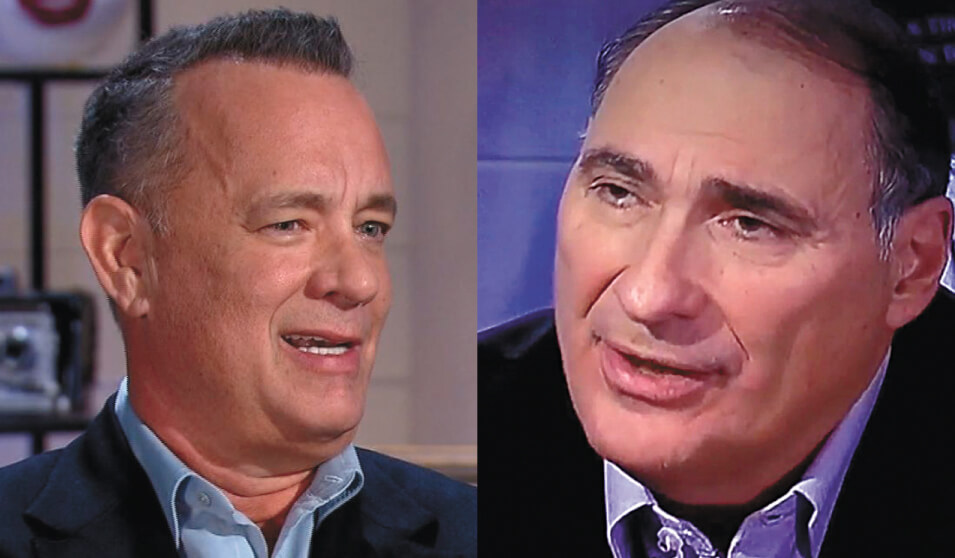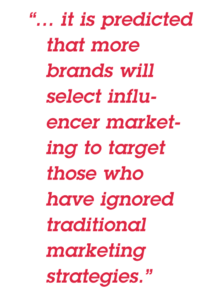In a world of growing uncertainty, we are invited to examine the trends of the New Year. The Fil-Am Voice staff extends to our readers best wishes and good cheer for 2018, as we touch on the newest trends in six arenas of central interest across the globe—education technology (Edtech), fashion, politics, sexual harassment, social media and superfoods. With instantaneous connection to most locales on the planet, at the touch of a button, we can for example, watch in real time on televisions and various mobile devices, along with millions of curious viewers, as Britain’s Prince Harry and American model Meghan Markle announce their engagement and a spring wedding in London. Hours later we are informed by the media that the jacket, dress and shoes worn by the future member of British royalty has already sold out in numerous local outlets. Such is the magic of modern media!

Photo courtesy Slate.com
Education Technology (Edtech)
In its relatively short history, technology has come to mean “disruption,” to long accepted educational traditions. In the words of Zishaan Havath in the October 18, 2017 issue of Inc 42, Disruptions in the education technology sector are now the next logical step. Advanced learning methodologies are being applied for students, while simultaneously eliminating bottlenecks faced by educators. The article is entitled, “Here are the Catalysts That Will Change the Education Domain in 2018”:
1. Mobile Learning. The smartphone is identified as the strongest disruptor in technology, which is now empowering students to embrace technology despite their geographical and socio-economic boundaries. By giving students good quality learning materials, it is also eliminating disparities in the quality of students’ education. In India, for example, mobile learning is found to enhance the learning curve of students, as it generates data which are analyzed by teachers, who can then personalize the content offered to students.
2. Cloud-Based Technology. As a centralized repository of knowledge for teachers and students alike, cloud-based technology lifts the problems inherent in previously limited classroom only usage to grant them the flexibility to interact and share data with each other—anytime, anywhere. Therefore, educators are helped to increase their reach without bearing the burden of expenses. while also reducing the end-cost for consumers, while adding considerable value to their education.
3. Big Data, Machine Learning, and Artificial Intelligence. “Big data helps to deeply analyze the usage and performance of students. By using machine learning and artificial intelligence together with big data, educators can create an adaptive platform that personalizes learning for students. By studying data sets, algorithms create behavior models. Based on these behavior models, educators can better understand students’ strengths and weaknesses and predict their unique learning curve. Educators can “create a personalized training path that meets the precise needs of each student. This lets students learn at a pace conducive to their own growth and keeps them motivated.”
4. Gamification is known to deliver superb results across applications and industries. In the form of games, it provides people a goal-based approach to their day-to-day tasks. To achieve this, gamification uses animations and interactive media. In education, each learning task is converted into smaller stage-like segments, which offer rewards or incentives upon successful completion. Since gamin tendencies are well-received by students since childhood, they respond to this approach much better, even in academic learning. Compared to the traditional classroom learning setup, gamification also decreases fatigue and increases their overall output considerably.
5. Augmented and Virtual Reality. Manifestations of Augmented Reality (AR) and the market deployment of Virtual Reality (VR) are now ubiquitous (being everywhere at the same time) across the globe. The education technology sector is also leveraging them to offer an enhanced and evolved learning experience for students. Compared to the traditional setup, AR and VR offer a more experiential learning experience to students. This experience registers much better in their minds, enhancing their retention and increasing their engagement. The increasing use of state-of-the-art technologies in both AR and VR is instrumental to evolve learning and increase the true academic potential of students. The edtech sector is proving itself to be very capable as an auxiliary support to classroom learning for students and an independent learning avenue for others. As technology increases its footprint in the market, the ed-tech sector will give us a glimpse of the ultra-modern education system of the future.
Fashion

Photo courtesy G•CUBE
We begin with the fashion trends for 2018, guided by the gurus of fashion design who look to the runways in four cities every year, beginning with New York City, then on to London, Milan, and Paris. What showed up in New York recently is a return to the 1980s, with acid washed jeans, bike shorts, chokers and slip dresses. In the presentations by Popsugar there were abundant examples of flannel, socks with shoes, short suits, and shimmering fabrics. There is also a comeback of the feminine stylings from Jane Austen’s era, in a modern day romance version of billowy sleeves, corseted waists, and soft floral prints. There is evidence of a lavender takeover, as well as dress-over pants, Western cowgirl, and an array of boots. Not totally erased, there is some use of monochromes and the traditional classic colors from Pantone, such as Sailor Blue, navy like; Harbor Mist – mid-tone dove gray; Warm Sand – neutral, comforting; and Coconut Milk – white/off-white mainstay.
From Pantone we are introduced to an attitude of boldness, defined in “12 call out shades,” to underscore a feeling of optimism and confidence in “colorful self-expression, kaleidoscopic flurry of uplifting shades and feel good tones.” Providing the palette includes a specific name for each shade with a brief description, which appear next in a condensed summary.
1. Meadowlark – subtle yellow
2. Cherry Tomato – orange red
3. Little Boy Blue – azure blue as promise of a new day
4. Chili Oil – earthy brown based red
5. Pink Lavender – soft, romantic violet rose, a soothing tone
6. Blooming Dahlia – understated pink
7. Arcadia – green with blue undertone
8. Ultraviolet – a complex purple shade
9. Emperador – rich chocolate infused brown
10. Almost Mauve – gentle, delicate ephemeral
11. Spring Crocus – flamboyant, tantalizing fuchsia
12. Lime punch – sharp, pungent, striking citrus.
In the popularization of the oversized jacket, some men’s fashion is blended into women’s designs. Each designer presented some version of The Naked Dress, sheer fabrics for transparency, some with jackets, slips or jeans. Some controversy arose with the appearance of the runways of plus sizes, and revealing pregnant bumps, leading one onlooker to comment “perhaps the catwalk is not the place for women in this period of their lives.” Of some surprise was the frequent show of fanny packs, as a strong trend being designed directly for use with specific dresses. In addition were creative styles with sequins, tassels, designer denim, geometric cut-outs, bold, graphic prints and a great variety of suits.
Filipinos are known for their keen interest in fashion, as from around the world they keep abreast of fashion trends, and we can expect this priority to continue in 2018.
Politics

Photo courtesy CNN
The changing landscape of political terminology gives us reason to pay attention to word usage. More specifically, what was once called “liberal” is now labeled “progressive,” while for some unexplained reason, “conservative” remains the same. Most agree that everyone basically wants the same things in life. The difference comes in disagreements about how to achieve these basic wants. What are some of the things we all want? Among the most noted on the short list are
1. healthy children,
2. a chance for prosperity,
3. little or no suffering,
4. no crime and
5. freedom.
According to Tom Hanks, in his recent interview on CNN with David Axelrod, what sets America apart from other nations is the freedom to express oneself without fear of repercussions. This kind of freedom is the envy of millions on the planet, many whose ancestors arrived on American shores to make a better life for their children and families.

Photo: Clarice Anne Cariño
An examination of contrasting beliefs between progressives and conservatives can be described briefly as follows: progressives look to the government to solve problems, to take actions that make possible equal opportunity and equality for all citizens; to act on its duty to improve social discrepancies and to protect civil liberties, as well as individual and human rights. Additionally, the government is given the role to guarantee that no citizen is in need. On the other hand, conservatives believe in empowering individuals to solve their own problems through personal responsibility, a strong national defense, free markets, individual liberty, limited government and traditional American values. Government is given the role to provide people with the freedom required to pursue their own goals and dreams. In general agreement, the two major political parties are usually termed as progressive for Democrats and conservatives for Republicans.
As we look to 2018, we see a growing divide between progressives (Democrats) and conservatives (Republicans) in America. Despite the fact that both houses of Congress are dominated by Republicans, as is the White House, coming to agreement remains a difficult task. The recent victory to narrowly pass the tax reform bill in the Senate is the only major win so far this year for the Republicans. The trend points to more division and a wider rift between progressives and conservatives in the coming months.
One bright spot is the higher visibility of women in elected office at all levels of government, although stll grossly under-represented in governments both nationally and internationally. Sadly, even though the U.S. is a nation known globally for promoting of the rights of women and girls, it has yet to elect a woman President. The modern day list of female heads of other nations remains short. Among the more familiar are: Kim Campbell, Prime Minister of Canada; Edith Cresson, Prime Minister of France; Julia Gillard, Prime Minister of Australia; Gold Meir, Prime Minister of Israel; Angela Merkel, Chancellor of Germany, Isabel Peron, President of Argentina; and Dilma Rousseff, President of Brazil, Margaret Thatcher, former Prime Minister and Theresa May, current Prime Minister of the United Kingdom and from the Philippines, former Presidents Corazon Aquino and Gloria Macapagal-Arroyo. There are 22 women world leaders currently in power.
Sexual Harassment
No doubt, one of the most troubling revelations on the daily news is the mounting number of allegations of sexual harassment in the workplace, bringing reactions of surprise, if not shock, to viewers. The U.S. Equal Opportunity Commission (EEOC) defines workplace sexual harassment as “sexual advances or conduct of a sexual nature which unreasonably interferes with the performance of a person’s job or creates an intimidating, hostile, or offensive work environment.” We further learn that “sexual harassment can range from persistent offensive sexual jokes to inappropriate touching to posting offensive material on a bulletin board. Sexual harassment at work is a serious problem and can happen to both women and men.”
Employees in both state and federal offices are protected by laws intended to prevent workplace violations. Under Title VII of the Civil Rights Act of 1964, sexual harassment is a form of sex discrimination. Title VII is the base for claims, but some states have even more strict sexual harassment laws. Following we provide information on two types of workplace sexual harassment, employer liability and strategies and procedures to put an end to this behavior.
The two types of workplace sexual harassment are
1. quid pro quo and
2. hostile work environment.
In the quid pro quo type of harassment, a person in authority demands that subordinates tolerate sexual harassment as a condition of getting or keeping a job or job benefit, including promotions and raises. A single instance of harassment is sufficient to sustain a quid pro quo claim. For example, a superior demands that you kiss him or her or lose your job. To qualify as a hostile work environment, a pattern of harassment is required.
Grounds for legal action based on hostile work environment is established when the behaviors are unwelcome, based on sex, and are severe or pervasive enough to cause an abusive or offensive workplace. In order to determine the validity of a hostile work environment claim, courts will analyze the following elements:
1. Whether the conduct was verbal, physical, or both;
2. Frequency of the conduct;
3. Whether the conduct was hostile or offensive;
4. Whether the alleged harasser was a co-worker or supervisor;
5. Whether others joined in perpetrating the harassment; and
6. Whether the harassment was directed at more than one individual or singled out the victim.
In these cases, the alleged victims are required to meet both a subjective and objective standard, and must show that:
1. he or she believed the conduct was hostile, abusive, or offensive, and
2. a reasonable person in the victim’s position would objectively believe the conduct was hostile, abusive or offensive.
In the area of employer liability, only employers with 15 or more employees are subject to Title VII consequences. State law governs the companies with fewer than 15 employees, and most states have in place laws to cover these workplace harassment claims. If either type of violation is proven, employers may be liable for punitive damages or compensatory rights, such as monetary loss, or pain and suffering claims. Liability may depend on who committed the harassment (co-worker or supervisor) and what corrective action was taken by the company. If a superior commits the harassment, the employer is liable if
1. there is actual employment action, such as firing, demoting, or negative changes in assignments or responsibilities, or
2. the harassment is shown to create a hostile work environment.
To defend against liability, the employer must show
1. exercise of reasonable care to prevent the harassment,
2. taking prompt corrective action to stop the unwanted behavior being told about it, and
3. that the employee unreasonably refused to take advantage of the corrective measures.
If the harassment is committed by a co-worker, the employer is liable if it knew or should have known about the harassment, and did not act immediately to correct the problem. Most importantly, let us remember that employer retaliation is illegal.
To stop sexual harassment, strategies are suggested for everyone at the workplace. For the employer, a personal effort must be demonstrated to end the unacceptable behaviors.
Training sessions must be provided for staff at all levels, based on the company’s policies in place, and in writing in the employee handbook. Everyone must take seriously the mandate to document in writing all complaints related to workplace harassment, including the action or lack of it when such complaints are reported to superiors. Probably, the best strategy is to avoid the legal battle in the courts of law by showing respect, kindness, and care for all who work together, and to do everything possible to maintain the workplace environment that everyone is comfortable to go to each day.
The growing trend to report these uncomfortable and embarrassing incidents is encouraging. Most victims are women who have held on, sometimes for years, to their shame, guilt and fear because they have learned from other victims that they will be blamed for having caused the harassment or for not being brave enough to ward off the harasser. Given the widespread allegations now coming forth every day, across the entire spectrum of socio-economic classes, including the news that Matt Lauer’s Dutch wife returned to her homeland last week, gives us reason to feel encouraged and hopeful that these behaviors will trend to a halt in 2018.
Social Media

Photo courtesy Business Insider
Don’t blink—you might miss the next social media trend for 2018. So, what’s more, you think it’s a passing fad? What’s here to stay, and what should you pay attention to? First, maybe it would be beneficial to examine what the term social media means. Random House, 2017, defines social media as “Websites and other online means of communication that are used by large groups of people to share information and to develop social and professional contacts.” Merriam-Webster lists social media as a noun, plural in usage, and defined as “forms of electronic communication through which people create online communities to share information, ideas, personal messages and the like.” Social media usually refers to social networking sites of which the following are most used.
1. Facebook – a site that allows user to create their personal profiles, share photos and videos, and communicate with other users;
2. Twitter – an internet service that allows users to post “tweets” for their followers to see updates in real time;
3. LinkedIn – a networking website for the business community that allows users to create professional profiles, post resumes, and communicate with other professionals and job-seekers;
4. Pinterest – an online community that allows users to display photos of items found on the web by “pinning” them and sharing ideas with others;
5. Snapchat – an app for mobile devices that allows users to send and share photos of themselves doing their daily activities.
To frame a perspective for looking ahead, it might be helpful at this time to remember the significant happenings in 2017 related to social media. The biggest stories remind us that the President of the United States communicates official policy positions in 140 character tweets almost daily, that Apple plans to alter the way we interact with our mobile devices, and that Facebook enticed Snapchat users towards Instagram. In the coming months, even more disruptions are expected as a number of new technological advancements go mainstream, while changing social norms related to social media come to the forefront.
Here are some of the trends for 2018.
1. Augmented Reality (AR) is expected to impact mobile gaming first, as announced by Apple at the initiating event in the Steve Jobs Theater, when introducing the iPhone 8 and iPhone X, in which a new chip will allow both phones to give “extraordinary augmented reality experiences,” and “it is likely that social media platforms will find ways to incorporate the new technology as well.” For those who are wondering what augmented reality is, Wikipedia defines it as “a live direct or indirect view of a physical, real-world environment whose elements are “augmented” by computer generated or extracted real-world sensory input such as sound, video, graphics, GPS data or haptics (the science of applying tactile sensation to computer applications in order to enable users to receive feedback in the form of felt sensations, mostly via the sense of touch.) First used in the entertainment and game businesses, other business industries are showing interest about possible AR uses, for example, in sharing knowledge, education, management of information and planning the details for distant meetings. Already familiar to most viewers are the overlays of supplemental information like scores over a live video feed of sporting events. Advanced AR technology also makes possible interactive and digitally manipulable information about the real world surroundings of the user. Finally, AR makes visible the components of the digital world into a person’s perceived real world. One such example is the AR Helmet used today by construction workers, that gives them information about construction sites. Originally invented in the early 1990s in the Armstrong Labs of the U.S. Air Force is the Virtual Fixtures system launched in 1992. In progress today, AR impacts the world of education as content is increasingly accessible by viewing or scanning an image with a mobile device.
2. Instagram Stories, now a year old, is increasing in popularity, as evidenced in the data which shows that 200 million use Instagram Stories each month—over 50 million more than the users of Snapchat. With this trend, it is expected that almost half of all Instagram users will move to Stories by the end of 2018.
3. Influencer Marketing is uniquely related to social media, often viewed as an outcome of the studies on social influence conducted by Harvard psychologist Herbert Kelman, who identified in 1958, three varieties of social influence, which are,
1. Compliance, when people appear to agree with others but actually keep their dissenting opinons private;
2. Identification, when people are influenced by somone who is liked and respected, such as a famous celebrity; and
3. Internalization, when people accept a belief or behavior and agree both publicly and privately.

Photo courtesy NDTV.com
Defined as a type of marketing that focuses on using key leaders to drive the brand’s message to the larger market, rather than marketing directly to consumers, the proponents of influencer marketing hire, pay, or inspire influencers to carry their message. Most campaigns include a social media component where influencers spread the message personally through their own means, using content provided by the marketers or their own. As a discipline of its own merits, influencer marketing emcompasses a few key actions, which are:
1. Identify key brand or product influencers;
2. Create a marketing campaign directed specifically at those influencers;
3. Create a secondary marketing campaign for the influencers to drive greater awareness to a larger set of target consumers; and
4. Track key metrics relating to reach, sales and brand awareness.
 At this time, over 90 percent of marketers who use the strategies of influencer marketing believe it is successful. North Face, Hubspot and Rolex are some companies who use social media-based influencer marketing strategies to improve connection with existing audiences and also to connect with new audiences. Due to the struggles faced in 2017 by companies who chose traditional advertising tools to attempt higher connecton with social media users, it is predicted that more brands will select influencer marketing to target those who have ignored traditional marketing strategies.
At this time, over 90 percent of marketers who use the strategies of influencer marketing believe it is successful. North Face, Hubspot and Rolex are some companies who use social media-based influencer marketing strategies to improve connection with existing audiences and also to connect with new audiences. Due to the struggles faced in 2017 by companies who chose traditional advertising tools to attempt higher connecton with social media users, it is predicted that more brands will select influencer marketing to target those who have ignored traditional marketing strategies.
4. Generation Z is a more valuable focus than millennials in 2018. Goldman Sachs conducted a study whose findings pointed to the 22 year olds of Generation Z as the most promising target, acknowledging that most are just entering the labor force and expected to have increasing purchase power for many years. As more brands recognize this prediction, they are likely to shift their social media investment to Snapchat and Instagram, both platforms known to be favorites of Gen Zers.
5. Messaging Platforms such as Kik, WhatsApp and Messenger are expected to create a shift away from social networks, as there is growing awareness of the 2.5 billion people using messaging platforms worldwide. Trending is greater investment in chatbots, voice assistants and artificial intelligence that offer personalized shopping experiences.
6. Live Streaming has transformed from novelty to mainstream in social media, as brands of all sizes are increasingly using live streaming to engage the attention of captivated followers. One example is GORUCK, who organizes extreme endurance events and manufactures backpacks, and has expanded its reach by live streaming gripping content on Facebook. In a recent endurance race, thousands tuned in to watch its 48-hour coverage. The power of live streaming will be incorporated into content plans regularly as more brands acknowledge likely benefits for their businesses.
7. Twitter is making a comeback from its lack of growth in 2017, in recognition of the information that LinkedIn, Instagram and Facebook all have more social media followers. Also, this year Twitter lost to Amazon the rights to streaming NFL (National Football League) games. 2018 is seen by Twitter executives as the likely time to rethink the operations of the platform. Among the possible changes being considered by Twitter leadership are the offering subcriptions, sale of the company to private investors, revamping advertising options to keep up with other platforms.
8. Digital Hangouts are used daily by Gen Zers to connect with friends. Over one million people daily use the video hangout platform Houseparty, whose success has Facebook researching ways to create similar functions on their platform. With video becoming more important in social media, live video group hangouts appear to be the next natural trend.
9. Facebook Spaces is a project being designed to enable friends to connect in virtual reality (VR), a result in part to its ownership of Oculus, a VR software and hardware company. Now poised to scale Spaces in 2018, it is probable that Facebook will be the first successful VR social media product at scale (to change the size of an object while maintaining its shape, as found in most graphics software.)
10. Governance Policies are being considered in light of controversies encountered during the 2016 presidential election, particularly the declarations of fake news made repeatedly by then candidate Trump, which he continues still as POTUS (President of the United States). Specifically, Facebook recently turned over thousands of ads that seem to be connected to Russian meddling in the 2016 election, resulting in Facebook investing in new artificial intelligence (AI) and human forms of monitoring. Additionally, we have learned that Facebook is testing fake new filtering overseas. Given the acceleration of social media trends, as presented above, it is increasingly likely that Twitter and Facebook will make adjustments in their policies to protect themselves from political criticism in the future, while also providing better online experiences for their growing numbers of users.
Superfoods
In a bid for optimal wellness, “superfoods” are now seen as a direct pathway to radiant health and boundless energy. What are the components of a superfood? According to a pamphlet from Whole Foods Market, superfoods have three main components, which are:
1. antidoxants that protect the body from wear and tear, while strengthening the immune system, muscles, bones and skin.
2. nutrients that consist of vitamins and minerals, including vitamin A (as carotemoids), vitamin C, the B vitamin folate, magnesium and potassium. Some superfoods also deliver protein, healthy carbohydrates and healthy fats, such as omega 3s and GLA (gamma-linolenic acid).
3. fiber that aids digestion, improves the absorption of certain nutrients and increases feelings of “fullness,” while decreasing the risk of certain diseases.
2017 turned to the healing properties of turmeric, macadamia nuts, and maca powder. We can expect that 2018 will be insect protein powder and hemp products, which are set to be huge, according to experts. The new alternatives, though a little strange sounding on the face of it, claim to offer myriad health benefits and are, of course, environmentally sustainable. According to nutritional medical practitioner, Fiona Tuck, crickets will be everywhere in 2018. Ms. Fiona further reported that the insects are not the sort you generally see hopping around the garden; they are grown and produced as a contamination-free food source. She outlined some of the benefits of cricket protein powder, and said that not only are they a sustainable food source, but they are also packed with vitamins and minerals. They also have B12 and iron which are common nutrients which we can become deficient in.
One of the biggest trends the health expert predicted for 2018 is hemp—especially as the product has recently become legal to sell in some parts of the U.S. and other countries, such as Australia. Ms. Fiona outlined how the food source is not only economical, it is also highly nutritious and comes loaded with vitamins. “You can have it as protein, you can have it as hemp flower seeds on our cereal or on your salad and oil as well,” she explained. For those concerned that hemp is in some way similar to marijuana, Ms. Fiona pointed out that while the two are from the same species, hemp is primarily used for industrial purposes.
It is no surprise that one of the up and coming superfoods that is now hitting the mainstream is “Moringa,” better known within the Filipino community as “Marunggay.” It is a multi-purpose plant, as the leaves, pods, fruits, flowers, roots and bark of the tree can be utilized. Some of the health benefits, according to scientific research, confirms that these humble leaves are a powerhoue of nutritional value. There are many benefits of the moringa tree but the health benefits are the most important. Research has sown that various parts of the moringa tree can be effective in a significant number of health concerns. Here is a quick look at a few of them, according to health experts:
1. Rich in Vitamin A, it contains four times more Vitamin A or beta-carotene than carrots; hence it is a weapon against blindness;
2. Rich in Vitamin C, many times more than oranges;
3. Leaves contain two times the protein present in milk;
4. Leaves contain several times more potassium than bananas;
5. Help in balancing the cholesterol levels in the body; and
6. Is also said to balance sugar levels; hence it is helpful in the fight against diabetes.
